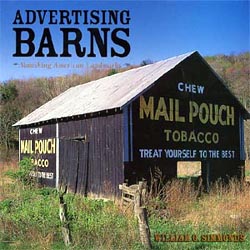Advertising Barns: Vanishing American Landmarks, by William G. Simmonds
We've all seen them -- old barns with huge painted slogans on the side or roof. They've been a feature of the American roadside for over a century. Condemned as eyesores back in the 1960s, advertising barns are now endangered and protected, even though the most prevalent barn-side promotion is for tobacco.
Ironic or otherwise, eyesores or not, advertising barns are now undeniably nostalgic remnants of a bygone era, and William G. Simmonds has done a marvelous job of immortalizing many of the remaining ones in his new book. Advertising Barns: Vanishing American Landmarks is the result of eight years and 45,000 miles on highways and country roads. In addition to finding and photographing dozens of colorful vintage structures, he "spent a lot of time reflecting" on what he saw. The result is a unique glimpse not only at the "vanishing landmarks," but also into the era and people that created them.
As Simmonds points out, probably the best-known barn ad is the one that exhorts passing travelers to "Chew Mail Pouch Tobacco. Treat Yourself to the Best." Mail Pouch barn ads were also the first, appearing in the late 1890s. The most successful and oldest continuous outdoor advertising campaign ever launched in America, the Mail Pouch barn-painting program inspired many imitators that linger to the present day. In 1998, Ohio's state bicentennial commission launched a campaign to adorn one barn in each of the state's 88 counties with a red-white-and-blue bicentennial logo. There are even newer barn ads sporting Web site addresses.
Although barn advertising isn't quite extinct, it's still a vanishing phenomenon. As Simmonds reveals in his chapter entitled "Life on the Scaffold," the medium lost its most famous artist when Harley Warrick passed away in 2000. A barn painter for nearly half a century, Warrick painted thousands of barns (and even an elephant!) during his colorful career. Simmonds interviewed Warrick before his death and includes his vivid descriptions of what it was like to travel the countryside with a truckload of paint.
Obviously a labor of love, Advertising Barns is a wonderful journey through the American countryside as well as a trip into the past. In addition to Mail Pouch barns, Simmonds covers the structures that tout tourist destinations like Rock City and Maramec Caverns as well as those promoting patent medicines from Fletcher's Castoria to Dr. Pierce's Pleasant Pellets. The photographs are excellent, as is Simmonds' thoughtful and well-researched text.
Lady Bird Johnson had lofty and far-reaching
goals when she set out to beautify America's highways in the
1960s. Fortunately, a sprinkling of painted barns escaped
her anti-billboard campaign, and even more fortunately, William
Simmonds has sought them out and captured them on film before
they are destroyed by other causes. It's easy to dismiss advertising
as having no cultural value or significance, but a closer
look through Simmonds' camera and commentary reveals a slice
of uniquely American history worth appreciating.
Megan
Edwards
1/2/05

